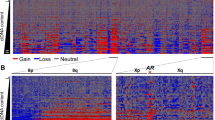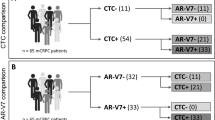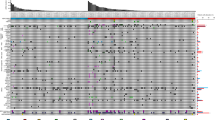Abstract
Background
The prognostic significance of plasma cell-free DNA (cfDNA) androgen receptor amplification (ARamp) in metastatic castration-resistant prostate cancer (mCRPC) compared with circulating tumor cell (CTC) counts is not known.
Methods
As part of correlative aims of a prospective study in mCRPC, concurrent and serial collections of plasma and CTCs were performed. Specimen collections were performed at baseline after progression on androgen deprivation therapy and then 12 weeks later. QuantStudio3D digital PCR system was used to determine plasma cfDNA AR copy number variations and Cell search assay for enumerating CTC counts. Association of baseline cfDNA ARamp status/CTC counts with overall survival (OS) (primary goal) was evaluated using Kaplan–Meier method and log-rank test (p ≤ 0.05 for significance) and receiver operator curves (ROCs) for ARamp status and CTC counts ≥5. A multivariate analysis was performed using Cox regression models that included ARamp, CTC counts, and other clinical factors.
Results
ARamp was detected in 19/70 patients at baseline. At the time of analysis, 28/70 patients had died (median follow-up 806 days; interquartile range: 535–966). ARamp was associated with poor OS (2-year OS of 35% in ARamp vs. 71% in non-ARamp; log-rank p value ≤0.0001). Baseline CTC counts ≥5 (vs. <5) was also associated with poor survival (2-year OS of 44 vs. 74%; log-rank p = 0.001). ROC analysis demonstrated area under the curve of 0.66 for ARamp-based prognosis and 0.68 for CTC count-based prognosis (p = 0.84 for difference). The best two variables included for multivariable analysis were ARamp and CTC counts ≥5; however, the two-factor model was not significantly better than using ARamp alone for predicting survival (hazard ratio = 5.25; p = 0.0002).
Conclusions
CTCs and plasma cfDNA ARamp were observed to have equal prognostic value in mCRPC. Larger cohorts that incorporate molecular and clinical factors are needed to further refine prognosis in CRPC.
This is a preview of subscription content, access via your institution
Access options
Subscribe to this journal
Receive 4 print issues and online access
$259.00 per year
only $64.75 per issue
Buy this article
- Purchase on Springer Link
- Instant access to full article PDF
Prices may be subject to local taxes which are calculated during checkout



Similar content being viewed by others
References
Siegel RL, Miller KD, Jemal A. Cancer statistics, 2016. CA Cancer J Clin. 2016;66:7–30.
Prostate Cancer Trialists Collaborative Group. Maximum androgen blockade in advanced prostate cancer: an overview of the randomised trials. Prostate Cancer Trialists’ Collaborative Group. Lancet. 2000;355:1491–8.
de Bono JS, Logothetis CJ, Molina A, Fizazi K, North S, Chu L, et al. Abiraterone and increased survival in metastatic prostate cancer. N Engl J Med. 2011;364:1995–2005.
Ryan CJ, Smith MR, de Bono JS, Molina A, Logothetis CJ, de Souza P, et al. Abiraterone in metastatic prostate cancer without previous chemotherapy. N Engl J Med. 2013;368:138–48.
Beer TM, Tombal B. Enzalutamide in metastatic prostate cancer before chemotherapy. N Engl J Med. 2014;371:1755–6.
Robinson D, Van Allen EM, Wu YM, Schultz N, Lonigro RJ, Mosquera JM, et al. Integrative clinical genomics of advanced prostate cancer. Cell. 2015;161:1215–28.
Grasso CS, Wu YM, Robinson DR, Cao X, Dhanasekaran SM, Khan AP, et al. The mutational landscape of lethal castration-resistant prostate cancer. Nature. 2012;487:239–43.
Beltran H, Eng K, Mosquera JM, Sigaras A, Romanel A, Rennert H, et al. Whole-exome sequencing of metastatic cancer and biomarkers of treatment response. JAMA Oncol. 2015;1:466–74.
Halabi S, Lin CY, Kelly WK, Fizazi KS, Moul JW, Kaplan EB, et al. Updated prognostic model for predicting overall survival in first-line chemotherapy for patients with metastatic castration-resistant prostate cancer. J Clin Oncol. 2014;32:671–7.
Danila DC, Heller G, Gignac GA, Gonzalez-Espinoza R, Anand A, Tanaka E, et al. Circulating tumor cell number and prognosis in progressive castration-resistant prostate cancer. Clin Cancer Res. 2007;13:7053–8.
van der Toom EE, Verdone JE, Gorin MA, Pienta KJ. Technical challenges in the isolation and analysis of circulating tumor cells. Oncotarget. 2016;7:62754–62766.
Romanel A, Gasi Tandefelt D, Conteduca V, Jayaram A, Casiraghi N, Wetterskog D, et al. Plasma AR and abiraterone-resistant prostate cancer. Sci Transl Med. 2015;7:312re310.
Heitzer E, Ulz P, Geigl JB. Circulating tumor DNA as a liquid biopsy for cancer. Clin Chem. 2015;61:112–23.
Xia S, Kohli M, Du M, Dittmar RL, Lee A, Nandy D, et al. Plasma genetic and genomic abnormalities predict treatment response and clinical outcome in advanced prostate cancer. Oncotarget. 2015;6:16411–21.
Carreira S, Romanel A, Goodall J, Grist E, Ferraldeschi R, Miranda S, et al. Tumor clone dynamics in lethal prostate cancer. Sci Transl Med. 2014;6:254ra125.
Wyatt AW, Azad AA, Volik SV, Annala M, Beja K, McConeghy B, et al. Genomic alterations in cell-free DNA and enzalutamide resistance in castration-resistant prostate cancer. JAMA Oncol. 2016;2:1598–606.
Ulz P, Belic J, Graf R, Auer M, Lafer I, Fischereder K, et al. Whole-genome plasma sequencing reveals focal amplifications as a driving force in metastatic prostate cancer. Nat Commun. 2016;7:12008.
Allard WJ, Matera J, Miller MC, Repollet M, Connelly MC, Rao C, et al. Tumor cells circulate in the peripheral blood of all major carcinomas but not in healthy subjects or patients with nonmalignant diseases. Clin Cancer Res. 2004;10:6897–904.
Scher HI, Morris MJ, Stadler WM, Higano C, Basch E, Fizazi K, et al. Trial design and objectives for castration-resistant prostate cancer: updated recommendations from the Prostate Cancer Clinical Trials Working Group 3. J Clin Oncol. 2016;34:1402–18.
Liu W, Laitinen S, Khan S, Vihinen M, Kowalski J, Yu G, et al. Copy number analysis indicates monoclonal origin of lethal metastatic prostate cancer. Nat Med. 2009;15:559–65.
Heitzer E, Ulz P, Geigl JB, Speicher MR. Non-invasive detection of genome-wide somatic copy number alterations by liquid biopsies. Mol Oncol. 2016;10:494–502.
Antonarakis ES, Lu C, Wang H, Luber B, Nakazawa M, Roeser JC, et al. AR-V7 and resistance to enzalutamide and abiraterone in prostate cancer. N Engl J Med. 2014;371:1028–38.
Antonarakis ES, Lu C, Luber B, Wang H, Chen Y, Zhu Y, et al. Clinical significance of androgen receptor splice variant-7 mRNA detection in circulating tumor cells of men with metastatic castration-resistant prostate cancer treated with first- and second-line abiraterone and enzalutamide. J Clin Oncol. 2017;35:2149–56.
Acknowledgements
We are grateful for the administrative assistance provided by Bobbi-Ann Jebens for this submission. We also would like to thank all patients who participated in this study for their selfless contribution in bringing precision medicine to future advanced prostate cancer patients. We highly appreciate the support of family members as well.
Funding:
This study is funded in part by the Mayo Clinic Center for Individualized Medicine; National Institutes of Health—National Cancer Institute (R01CA21209) to MK and LW; Department of Defense (W81XWH-15-1-0634) to MK and SMD; and Mayo Clinic Schulze Center for Novel Therapeutics in Cancer Research to MK and LW; Joseph and Gail Gassner to MK; and Advancing a Healthier Wisconsin Fund (#5520227) and National Institutes of Health (R01CA157881) to LW; National Institutes of Health—National Cancer Institute (R01CA174777) to SMD.
Author information
Authors and Affiliations
Corresponding authors
Ethics declarations
Conflict of interest
The authors declare that they have no conflict of interest.
Additional information
Co-First authors: Manish Kohli, Jian Li.
Rights and permissions
About this article
Cite this article
Kohli, M., Li, J., Du, M. et al. Prognostic association of plasma cell-free DNA-based androgen receptor amplification and circulating tumor cells in pre-chemotherapy metastatic castration-resistant prostate cancer patients. Prostate Cancer Prostatic Dis 21, 411–418 (2018). https://doi.org/10.1038/s41391-018-0043-z
Received:
Revised:
Accepted:
Published:
Issue Date:
DOI: https://doi.org/10.1038/s41391-018-0043-z
This article is cited by
-
Genetic profiling of hormone-sensitive and castration-resistant prostate cancers and identification of genetic mutations prone to castration-resistant prostate cancer
Prostate Cancer and Prostatic Diseases (2023)
-
Androgen receptor gain in circulating free DNA and splicing variant 7 in exosomes predict clinical outcome in CRPC patients treated with abiraterone and enzalutamide
Prostate Cancer and Prostatic Diseases (2021)
-
Prognostic significance of total plasma cell-free DNA level and androgen receptor amplification in castration-resistant prostate cancer
World Journal of Urology (2021)
-
Harnessing cell-free DNA: plasma circulating tumour DNA for liquid biopsy in genitourinary cancers
Nature Reviews Urology (2020)
-
Plasma cell-free DNA-based predictors of response to abiraterone acetate/prednisone and prognostic factors in metastatic castration-resistant prostate cancer
Prostate Cancer and Prostatic Diseases (2020)



